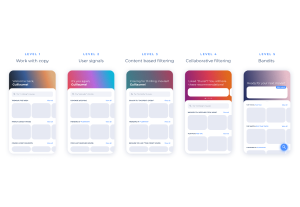- Customer Experience, Design, Product design, Usability, UX Education, UX Magazine
Personalization can be a powerful tool for engagement. Here are 5 levels of product personalization that can make the best of your recommender systems.
Article by Guillaume Galante
5 levels of product personalization: an intro to recommender systems
- Personalization is a powerful tool for engagement, increasing customer retention and beneficial to acquiring new customers.
- When working with personalization:
- Work with your copywriters and be creative
- Watch user signals
- Filter content
- Create collaborative filtering
- Practice “Bandits” models
Share:5 levels of product personalization: an intro to recommender systems
Share this link
- May 3, 2022
5 min read







